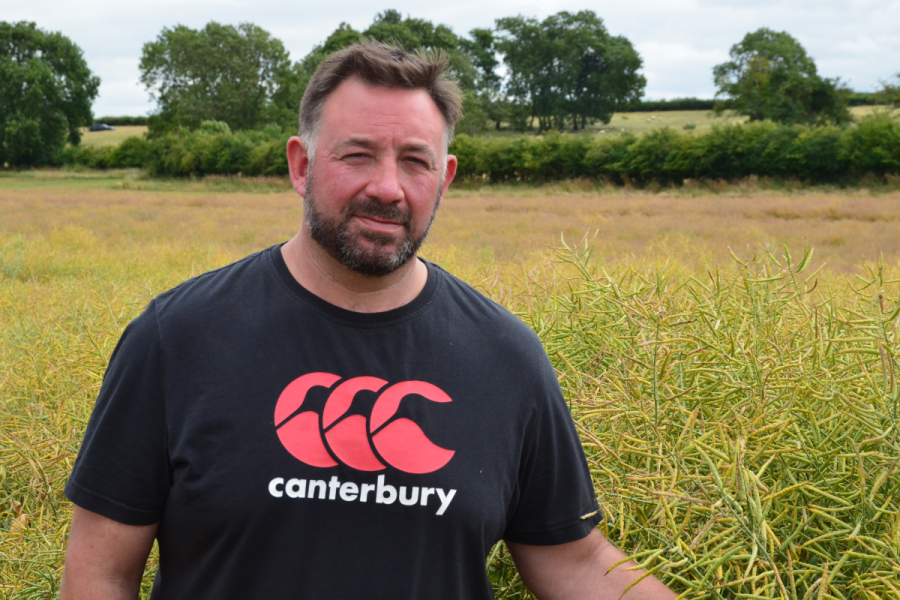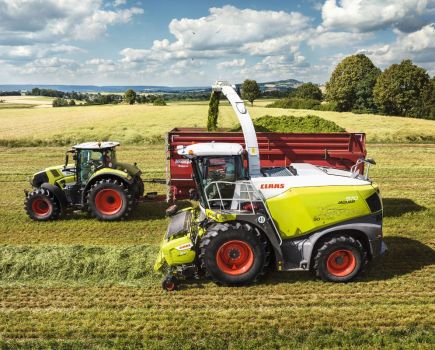It’s horses for courses when it comes to establishment systems. CPM visits a Lincolnshire farmer who’s been on the journey that’s encompassed the extremes of tillage before settling for a strip tillage system.
“The key is to understand the concept and how to get the best from it.”
By Rob Jones
When it comes to crop establishment, Lincolnshire farmer Will Gilman has been on a journey from traditional deep cultivations involving ploughing, to min-till, and then to the other extreme, direct drilling with zero cultivations. Now all crops are direct strip seeded using the Claydon Opti-Till System, which he feels best suits the requirements of his family’s business.
Farming 730ha of arable land – part of it owned, part on FBTs and part contracted – his business, HP Gilman & Partners is based at Grange Farm, Pickworth near Stamford. Formerly part of the Burghley Estate, it had been tenanted since 1904 by three generations of the Gilman family and when it came up for sale in 2009, they decided to grasp the opportunity.
Will operates what he describes as a ‘tight rotation’ simply because it’s difficult to find alternative crops that suit the thin limestone brash soils which make up half of the farmed area, the remainder being heavy clay.
“We’re very limited as to what we can grow, so our approach is very commercial and we keep things as simple as possible,” he explains. “For 10 years, feed wheat and oilseed rape were the only crops grown here and, although we have added others, they generate the highest margins and remain the mainstay. Output and margins drive everything that we do, so it’s a fairly high input system and there’s no skimping when it comes to inputs such as fertilisers or agchem.”
For the 2022 harvest, the business grew 320ha of winter wheat, comprising soft Group 4 LG Skyscraper, together with hard Group 4 varieties Gleam and a newcomer to the AHDB 2022/23 Recommended List, KWS Dawsum.
In that same year, the cropping also included 200ha of winter OSR, all conventional varieties produced from farm-saved seed, plus 150ha of winter and spring beans, a little spring barley, with various environmental schemes accounting for the balance. The enterprise encompasses two diversification projects, livery for 35 horses and Rutland Simulated Game, a simulated game shoot which has proved extremely popular.
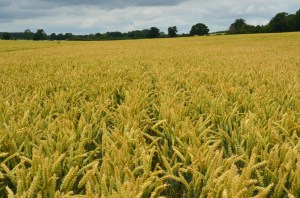
Strip seeded rows are clearly visible in this crop of LG Skyscraper winter wheat just before the 2022 harvest. The space between rows is kept clear of weeds using a 6m Claydon TerraBlade inter-row hoe.
In addition to their own land, the Gilman family also contract-farm land for two neighbours, all of it falling within a ring fence and being connected by 4km of tracks.
“Until 2010 we operated a full cultivations system, with part of the land ploughed and part min-tilled using a Horsch Terrano, then drilled with a Väderstad Rapid,” says Will, adding that the drawbacks were significant in terms of timeliness, cost and labour.
“We had an ageing workforce with two staff due to retire, so that was a significant concern and led me to review our approach. I also wanted to trim costs and minimise soil disturbance to reduce weather risk – a major advantage of strip seeding as it avoids having large areas of cultivated soil exposed and being caught out by heavy rain.
“I looked at two alternatives. One was the Claydon Opti-Till System, the other the John Deere 750A – a true direct drill. In my eyes, the full direct drill approach was too risky, so I bought a 6m Claydon Hybrid mounted drill and used it very successfully for two seasons.
“Much of our land has stone underlying the topsoil – we even have a quarry on the farm which supplies stone used on buildings such as the Houses of Parliament – so I decided to change it for the same model, but with stone release instead of the normal shear-bolt protected tines,” he explains.
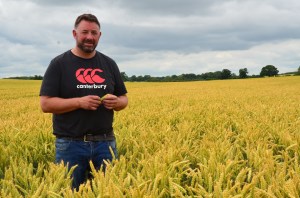
Will Gilman stands in a conventional crop of OSR, a crop which remains a key crop at Grange Farm, where alternatives struggle to generate sufficient margins.
“After operating the Hybrid for five years, I felt that our soils had improved sufficiently to allow true direct drilling and in 2017 we bought a Weaving GD trailed direct drill. With hindsight that was a mistake. Yields dropped by 15%, we were forced to drill earlier to make it work, nitrogen mineralisation was much reduced, and blackgrass seemed to grow more strongly throughout the winter.
“The other major issue was that there was no way to relieve the compaction caused by a heavy trailed direct drill if the weather turned wet, which was particularly evident on headlands and caused significant issues. That was important because, even though our average field size is 15ha, headlands account for a significant area of the farm,” comments Will.
“I concluded that although pure direct drilling is a concept which sounds good in theory, in practice it doesn’t work well enough here or consistently enough over the longer-term for us. I missed the tine concept and experience had shown yields from the Claydon Opti-Till System were significantly higher, so in 2020 I sold the Weaving and bought a new 6m Claydon Hybrid.”
Will also bought a 6m Claydon Terra-Blade inter-row hoe last year to take out any weeds growing between the rows. “That approach has brought yields back up to their former levels and allowed us to drill later to help combat blackgrass.”
It’s an approach that seems to be working. “The Claydon is used to drill all our OSR in August, straight behind the combine,” says Will. “The leading tines are run as shallow as possible to avoid bring up any of the underlying clay and we keep an eye on levels to ensure that the seed goes in at an even depth.”
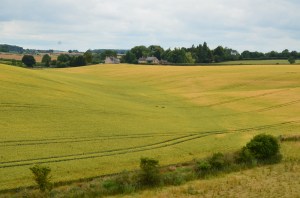
The undulating land at Grange Farm includes a wide range of soil types, from limestone brash to heavy clay.
And it truly is a family affair with the eldest of Will’s three sons, age 15, drilling all the OSR and his 13-year-old helping with harvest.
The Gilman’s new drill is pulled by a 300hp Case IH Optum 300 CVX, which works alongside the farm’s other tractor, a 175hp Case IH Puma 175, both supplied by local Case IH and Claydon dealer, Sharmans Agricultural in Stamford. The Optum has an excellent power-to-weight ratio and could easily operate much faster than the 9-10 km/h which Will prefers to minimise soil disturbance.
“The aim is to leave 25cm stubble behind our 12m Claas Lexion 770 combine, then drill at an angle to the tramlines to help keep fields level. We sow winter wheat about 50mm deep using a seed rate which varies from 180 seeds/m2 in mid-September to 220 seeds/m2 at the end of October.
“I have found that certain varieties suit the Claydon system better than others. Gleam, for example, tillers like crazy and helps to crowd out blackgrass which, along with cow parsley and cleavers, can be an issue in places. I like the fact that now we can hoe between the rows with our TerraBlade on the front linkage of the Puma 175, so it’s very much an add-on to our system which enhances the effect of herbicides rather than trying to replace them,” he adds.
“We use the TerraBlade as early as possible in the spring, usually February to take out any weeds growing between the rows before they have too much opportunity to develop and become difficult to control. The blades also break up any capping that has developed over winter and aerates the soil.”
Like all farms, Will has a sharp eye on costs. “Buying the farm increased our overheads considerably so we must focus on keeping costs in check and growing crops which produce the highest gross margin,” he says.
“Attention to detail is essential to get the most out of them on this hungry ground, so as part of that we apply chicken manure from local poultry farms at 7t/ha and Severn Trent treated sewage sludge at 22t/ha, often drilling crops directly through that using the Claydon Hybrid. Our winter wheats averaged 10t/ha last year and we hedge risk by selling some of our production forward, with commitments already in place for November 2023.”
Although it’s been a journey to find the right regime for his soils, Will reckons he now has it about right. “Since switching from conventional direct drilling to direct strip seeding, the performance of our crops has vastly improved, particularly on headlands.
“The key is to understand the concept and how to get the best from it. We find all our Claydon products are simple, easy to maintain and inexpensive to operate. Apart from a broken weld on the steps of the drill we’ve not had any issues and the back-up from Claydon, through Sharmans, has been really good.”
Farm Facts
HP Gilman & Partners, Grange Farm, Pickworth, Stamford, Lincolnshire.
- Arable area: 730h
- Cropping: winter wheat, winter OSR, winter and spring beans, spring barley
- Soil type: Limestone brash and heavy clay
- Mainline tractors: 300hp Case IH Optum 300 CVX; 175hp Case IH Puma 175
- Combine: 12m Claas Lexion 770
- Cultivation equipment: 6m Claydon Hybrid; 6m Claydon Terra-Blade
This article was taken from the latest issue of CPM. For more articles like this, subscribe here.
Sign up for Crop Production Magazine’s FREE e-newsletter here.

